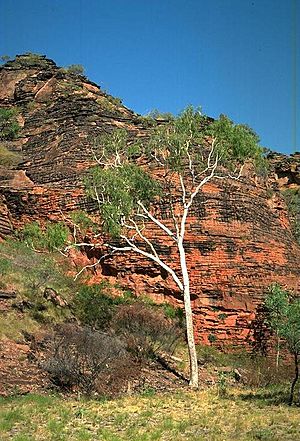Small-fruited bloodwood facts for kids
Quick facts for kids Small-fruited bloodwood |
|
|---|---|
 |
|
| Corymbia dichromophloia near Kununurra | |
| Scientific classification | |
| Genus: |
Corymbia
|
| Species: |
dichromophloia
|
| Synonyms | |
|
Synonyms
Corymbia capricornia (D.J.Carr & S.G.M.Carr) K.D.Hill & L.A.S.Johnson
Corymbia drysdalensis (D.J.Carr & S.G.M.Carr) K.D.Hill & L.A.S.Johnson Corymbia rubens K.D.Hill & L.A.S.Johnson Eucalyptus atrovirens Brooker & Kleinig Eucalyptus capricornia D.J.Carr & S.G.M.Carr Eucalyptus coniophloia D.J.Carr & S.G.M.Carr Eucalyptus dichromophloia F.Muell. Eucalyptus drysdalensis D.J.Carr & S.G.M.Carr Eucalyptus niphophloia Blakely & Jacobs |
|
The Small-fruited Bloodwood (scientific name: Corymbia dichromophloia) is a special tree found only in northern Australia. It is also known as the Variably-barked Bloodwood or Gum-topped Bloodwood. This tree has smooth, white bark. Sometimes, its trunk has thin, flaky bark. Its adult leaves are shaped like a spear. The tree produces creamy white flowers. These flowers grow from buds that usually appear in groups of seven. After flowering, it grows urn-shaped fruits.
What Does It Look Like?
The Small-fruited Bloodwood is a tree that usually grows to be about 12 to 15 meters (around 40 to 50 feet) tall. It has a special woody swelling at its base called a lignotuber. This helps the tree regrow if it gets damaged.
Its bark is smooth and white. Sometimes, it can look a bit powdery. You might also see thin, orange and brownish flakes on the trunk and upper branches.
Leaves
Young plants have leaves that are egg-shaped or broadly spear-shaped. These leaves are about 9.5 to 22 cm (3.7 to 8.7 inches) long. They are also about 5.5 to 10 cm (2.2 to 3.9 inches) wide. These young leaves have stalks.
Adult leaves grow in an alternating pattern along the branches. They are the same dull or slightly shiny green color on both sides. These leaves are spear-shaped or curved. They can be 7 to 23 cm (2.8 to 9.1 inches) long. Their width ranges from 0.8 to 5.5 cm (0.3 to 2.2 inches). Each leaf narrows down to a stalk that is about 0.9 to 3.4 cm (0.4 to 1.3 inches) long.
Flowers and Fruit
The tree's flower buds grow at the ends of its small branches. They are arranged on a branched stalk called a peduncle. This stalk is usually 1 to 17 mm long. Each part of the peduncle holds seven, sometimes nine or eleven, buds. These buds sit on smaller stalks called pedicels, which are 1 to 11 mm long.
When the buds are ready, they are oval, pear-shaped, or round. They are 4 to 7 mm long and 3 to 5 mm wide. Each bud has a rounded cap, known as an operculum. The tree blooms between February and May. Its flowers are a lovely creamy white color.
After the flowers, the tree produces a woody, urn-shaped fruit. This fruit is a type of capsule. It is 8 to 13 mm long and 6 to 11 mm wide. The seeds inside are reddish-brown and shaped like a small boat. They have a wing on one end, which helps them spread.
How It Got Its Name
This type of eucalypt tree was first officially described in 1859. A scientist named Ferdinand von Mueller gave it the name Eucalyptus dichromophloia. He wrote about it in a scientific journal.
Later, in 1995, two other botanists, Ken Hill and Lawrie Johnson, changed its name. They renamed it Corymbia dichromophloia. This new name placed it in a different group of trees.
Sometimes, scientists have different ideas about how to classify plants. For this tree, there has been some discussion. Other names like Corymbia capricornia, C. drysdalensis, and C. rubens have been used. This shows that even scientists sometimes debate the best way to group similar trees.
Where Does It Grow?
The Small-fruited Bloodwood tree grows in woodlands. You can find it on hills, ridges, and plains. It also grows near river banks. It prefers red or yellow sandy soils. These soils are often found over granite or sandstone rocks.
This tree is found across northern Australia. In Western Australia, it grows in the Kimberley region and the King Leopold Ranges. In the Northern Territory, it is found in the Top End and as far south as Katherine. You can also see it in Queensland, near places like Mount Isa, Cloncurry, and Normanton.

